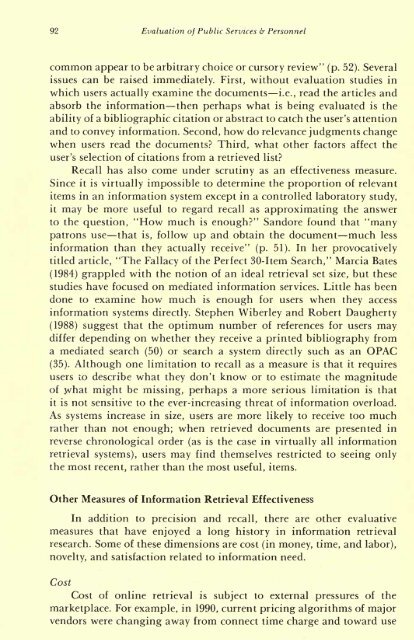User-Centered Evaluation of Information Retrieval - ideals
User-Centered Evaluation of Information Retrieval - ideals
User-Centered Evaluation of Information Retrieval - ideals
You also want an ePaper? Increase the reach of your titles
YUMPU automatically turns print PDFs into web optimized ePapers that Google loves.
92 <strong>Evaluation</strong> <strong>of</strong> Public Services & Personnel<br />
common appear to be arbitrary choice or cursory review" (p. 52). Several<br />
issues can be raised immediately. First, without evaluation studies in<br />
which users actually examine the documents i.e., read the articles and<br />
absorb the information then perhaps what is<br />
being evaluated is the<br />
ability <strong>of</strong> a bibliographic citation or abstract to catch the user's attention<br />
and to convey information. Second, how do relevance judgments change<br />
when users read the documents? Third, what other factors affect the<br />
user's selection <strong>of</strong> citations from a retrieved list?<br />
Recall has also come under scrutiny as an effectiveness measure.<br />
Since it is virtually impossible to determine the proportion <strong>of</strong> relevant<br />
items in an information system except in a controlled laboratory study,<br />
it may be more useful to regard recall as approximating the answer<br />
to the question, "How much is enough?" Sandore found that "many<br />
patrons use that is, follow up and obtain the document much less<br />
information than they actually receive" (p. 51). In her provocatively<br />
titled article, "The Fallacy <strong>of</strong> the Perfect 30-1 tem Search," Marcia Bates<br />
(1984) grappled with the notion <strong>of</strong> an ideal retrieval set size, but these<br />
studies have focused on mediated information services. Little has been<br />
done to examine how much is enough for users when they access<br />
information systems directly. Stephen Wiberley and Robert Daugherty<br />
(1988) suggest that the optimum number <strong>of</strong> references for users may<br />
differ depending on whether they receive a printed bibliography from<br />
a mediated search (50) or search a system directly such as an OPAC<br />
(35). Although one limitation to recall as a measure is that it requires<br />
users to describe what they don't know or to estimate the magnitude<br />
<strong>of</strong> what might be missing, perhaps a more serious limitation is that<br />
it is not sensitive to the ever-increasing threat <strong>of</strong> information overload.<br />
As systems increase in size, users are more likely to receive too much<br />
rather than not enough; when retrieved documents are presented in<br />
reverse chronological order (as is the case in virtually all information<br />
retrieval systems), users may find themselves restricted to seeing only<br />
the most recent, rather than the most useful, items.<br />
Other Measures <strong>of</strong> <strong>Information</strong> <strong>Retrieval</strong> Effectiveness<br />
In addition to precision and recall, there are other evaluative<br />
measures that have enjoyed a long history<br />
in information retrieval<br />
research. Some <strong>of</strong> these dimensions are cost (in money, time, and labor),<br />
novelty, and satisfaction related to information need.<br />
Cost<br />
Cost <strong>of</strong> online retrieval is subject to external pressures <strong>of</strong> the<br />
marketplace. For example, in 1990, current pricing algorithms <strong>of</strong> major<br />
vendors were changing away from connect time charge and toward use
















